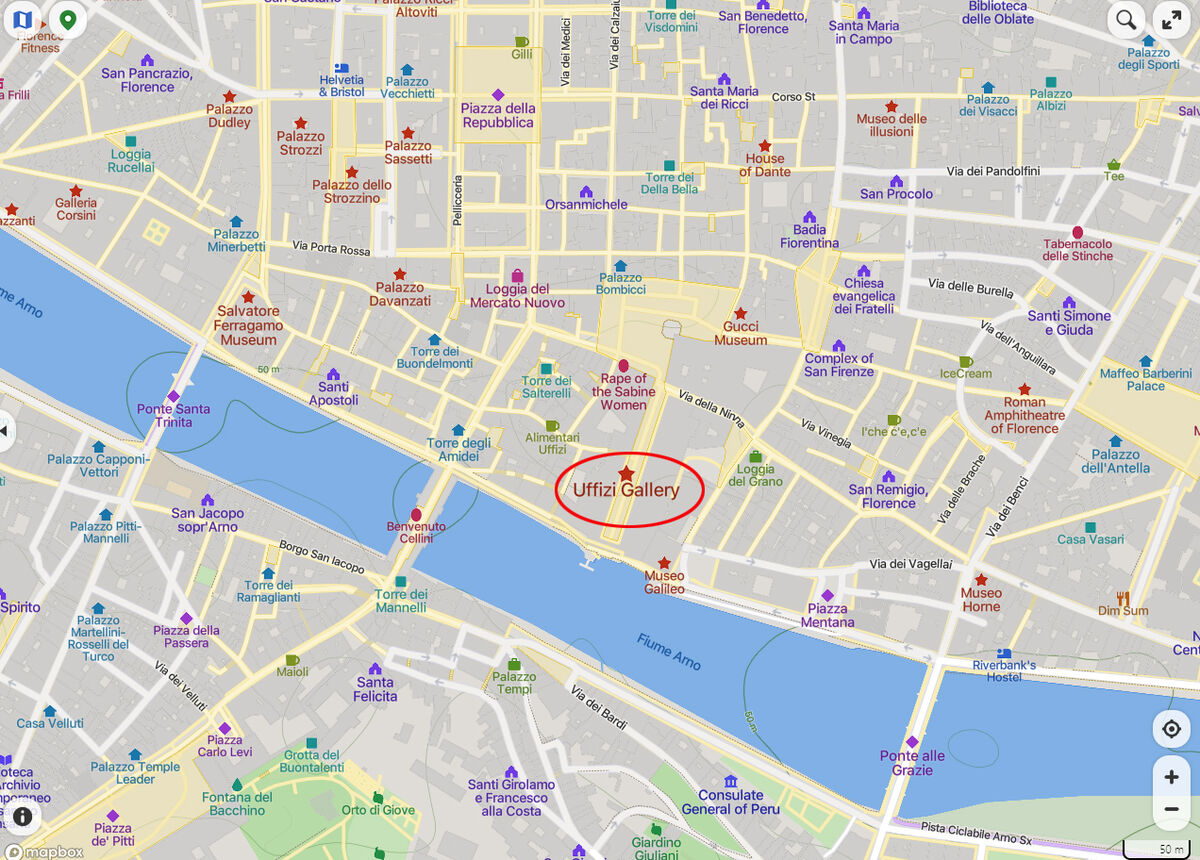Italy: Florence Part 26 - The Uffizi Gallery
Aug 23, 2023 14:52:17 #
We braved the crowds for a tour of the Uffizi Gallery. The noise level was oppressive, especially when we encountered groups of unruly teens who our guide (a middle school teacher) called "the monsters"! Note that some of the paintings may appear tilted since they were not taken head on. Despite my skills as an offensive lineman, I could not get through the crowd to line up the shots properly.
The Uffizi Gallery (UK: /juːˈfɪtsi, ʊˈfiːtsi/, yoo-FIT-see, uu-FEET-see;Italian: Galleria degli Uffizi, pronounced [ɡalleˈriːa deʎʎ ufˈfittsi]) is a prominent art museum located adjacent to the Piazza della Signoria in the Historic Centre of Florence in the region of Tuscany, Italy. One of the most important Italian museums and the most visited, it is also one of the largest and best known in the world and holds a collection of priceless works, particularly from the period of the Italian Renaissance.
After the ruling House of Medici died out, their art collections were given to the city of Florence under the famous Patto di famiglia negotiated by Anna Maria Luisa, the last Medici heiress. The Uffizi is one of the first modern museums. The gallery had been open to visitors by request since the sixteenth century, and in 1769 it was officially opened to the public, formally becoming a museum in 1865.
History
Uffizi is ranked as the 25th on the most visited art museums in the world, with around 2 million visitors annually.
The building of the Uffizi complex was begun by Giorgio Vasari in 1560 for Cosimo I de' Medici as a means to consolidate his administrative control of the various committees, agencies, and guilds established in Florence's Republican past so as to accommodate them all one place, hence the name uffizi, "offices". The construction was later continued by Alfonso Parigi and Bernardo Buontalenti; it was completed in 1581. The top floor was made into a gallery for the family and their guests and included their collection of Roman sculptures.
The cortile (internal courtyard) is so long, narrow and open to the Arno at its far end through a Doric screen that articulates the space without blocking it, that architectural historians treat it as the first regularized streetscape of Europe. Vasari, a painter and architect as well, emphasised its perspective length by adorning it with the matching facades' continuous roof cornices, and unbroken cornices between storeys, as well as the three continuous steps on which the palace-fronts stand. The niches in the piers that alternate with columns of the Loggiato filled with sculptures of famous artists in the 19th century.
Tribuna degli Uffizi
The Uffizi brought together under one roof the administrative offices and the Archivio di Stato, the state archive. The project was intended to display prime art works of the Medici collections on the piano nobile; the plan was carried out by his son, Grand Duke Francesco I. He commissioned the architect Buontalenti to design the Tribuna degli Uffizi that would display a series of masterpieces in one room, including jewels; it became a highly influential attraction of a Grand Tour. The octagonal room was completed in 1584.
Over the years, more sections of the palace were recruited to exhibit paintings and sculpture collected or commissioned by the Medici. For many years, 45 to 50 rooms were used to display paintings from the 13th to 18th century.
Modern times
Because of its huge collection, some of the Uffizi's works have in the past been transferred to other museums in Florence—for example, some famous statues to the Bargello. A project was finished in 2006 to expand the museum's exhibition space some 6,000 metres2 (64,000 ft2) to almost 13,000 metres2 (139,000 ft2), allowing public viewing of many artworks that had usually been in storage.
The Nuovi Uffizi (New Uffizi) renovation project which started in 1989 was progressing well in 2015 to 2017. It was intended to modernize all of the halls and more than double the display space. As well, a new exit was planned and the lighting, air conditioning and security systems were updated. During construction, the museum remained open, although rooms were closed as necessary with the artwork temporarily moved to another location. For example, the Botticelli rooms and two others with early Renaissance paintings were closed for 15 months but reopened in October 2016.
The major modernization project, New Uffizi, had increased viewing capacity to 101 rooms by late 2016 by expanding into areas previously used by the Florence State Archive.
The Uffizi hosted over two million visitors in 2016, making it the most visited art gallery in Italy. In high season (particularly in July), waiting times can be up to five hours. Tickets are available on-line in advance, however, to significantly reduce the waiting time. A new ticketing system is currently being tested to reduce queuing times from hours to just minutes. The museum is being renovated to more than double the number of rooms used to display artwork.
Due to the COVID-19 pandemic, the museum was closed for 150 days in 2020, and attendance plunged by 72 percent to 659,043. Nonetheless, the Uffizi was twenty-seventh in the list of most-visited art museums in the world in 2020. Works from the Uffizi gallery collection are now available for remote viewing on Google Arts and Culture. The museum reopened in May 2021 following a renovation that included an addition of 14 new rooms and a display of additional 129 artworks, with the museum attempting to give more voice to historically underrepresented groups that include women and people of color.
Incidents
On 27 May 1993, the Sicilian Mafia carried out a car bomb explosion in Via dei Georgofili which damaged parts of the palace and killed five people. The blast destroyed five pieces of art and damaged another 30. Some of the paintings were fully protected by bulletproof glass. The most severe damage was to the Niobe room and classical sculptures and neoclassical interior, which have since been restored, although its frescoes were damaged beyond repair.
Key works
Cimabue: Santa Trinita Maestà
Duccio: Rucellai Madonna
Giotto: Ognissanti Madonna, Badia Polyptych
Simone Martini: Annunciation with St. Margaret and St. Ansanus
Ambrogio Lorenzetti: Presentation at the Temple
Gentile da Fabriano, Adoration of the Magi
Paolo Uccello: The Battle of San Romano
Rogier van der Weyden: Lamentation of Christ
Fra Filippo Lippi: Madonna and Child, Coronation of the Virgin
Piero della Francesca: Diptych of Duke Federico da Montefeltro and Duchess Battista Sforza of Urbino
Andrea del Verrocchio: The Baptism of Christ
Hugo van der Goes: Portinari Triptych
Sandro Botticelli: Primavera, The Birth of Venus, Adoration of the Magi of 1475 and others
Michelangelo: The Holy Family (Doni Tondo)
Leonardo da Vinci: The Annunciation, Adoration of the Magi
Piero di Cosimo: Perseus Freeing Andromeda
Albrecht Dürer: Adoration of the Magi
Raphael: Madonna of the Goldfinch, Portrait of Leo X
Titian: Flora, Venus of Urbino
Parmigianino: Madonna with the Long Neck
Caravaggio: Bacchus, Sacrifice of Isaac, Medusa
Artemisia Gentileschi: Judith and Holofernes
Rembrandt: Self-portrait as a Young Man (attribution doubtful), Self-portrait as an Old Man, Portrait of an Old Man
The collection also contains some ancient sculptures, such as the Arrotino, the Two Wrestlers and the Bust of Severus Giovanni.
Please see my previous set for a nice exterior view.
https://www.uglyhedgehog.com/t-783960-1.html#14112965
I hope you enjoy these!
Mark
The Uffizi Gallery (UK: /juːˈfɪtsi, ʊˈfiːtsi/, yoo-FIT-see, uu-FEET-see;Italian: Galleria degli Uffizi, pronounced [ɡalleˈriːa deʎʎ ufˈfittsi]) is a prominent art museum located adjacent to the Piazza della Signoria in the Historic Centre of Florence in the region of Tuscany, Italy. One of the most important Italian museums and the most visited, it is also one of the largest and best known in the world and holds a collection of priceless works, particularly from the period of the Italian Renaissance.
After the ruling House of Medici died out, their art collections were given to the city of Florence under the famous Patto di famiglia negotiated by Anna Maria Luisa, the last Medici heiress. The Uffizi is one of the first modern museums. The gallery had been open to visitors by request since the sixteenth century, and in 1769 it was officially opened to the public, formally becoming a museum in 1865.
History
Uffizi is ranked as the 25th on the most visited art museums in the world, with around 2 million visitors annually.
The building of the Uffizi complex was begun by Giorgio Vasari in 1560 for Cosimo I de' Medici as a means to consolidate his administrative control of the various committees, agencies, and guilds established in Florence's Republican past so as to accommodate them all one place, hence the name uffizi, "offices". The construction was later continued by Alfonso Parigi and Bernardo Buontalenti; it was completed in 1581. The top floor was made into a gallery for the family and their guests and included their collection of Roman sculptures.
The cortile (internal courtyard) is so long, narrow and open to the Arno at its far end through a Doric screen that articulates the space without blocking it, that architectural historians treat it as the first regularized streetscape of Europe. Vasari, a painter and architect as well, emphasised its perspective length by adorning it with the matching facades' continuous roof cornices, and unbroken cornices between storeys, as well as the three continuous steps on which the palace-fronts stand. The niches in the piers that alternate with columns of the Loggiato filled with sculptures of famous artists in the 19th century.
Tribuna degli Uffizi
The Uffizi brought together under one roof the administrative offices and the Archivio di Stato, the state archive. The project was intended to display prime art works of the Medici collections on the piano nobile; the plan was carried out by his son, Grand Duke Francesco I. He commissioned the architect Buontalenti to design the Tribuna degli Uffizi that would display a series of masterpieces in one room, including jewels; it became a highly influential attraction of a Grand Tour. The octagonal room was completed in 1584.
Over the years, more sections of the palace were recruited to exhibit paintings and sculpture collected or commissioned by the Medici. For many years, 45 to 50 rooms were used to display paintings from the 13th to 18th century.
Modern times
Because of its huge collection, some of the Uffizi's works have in the past been transferred to other museums in Florence—for example, some famous statues to the Bargello. A project was finished in 2006 to expand the museum's exhibition space some 6,000 metres2 (64,000 ft2) to almost 13,000 metres2 (139,000 ft2), allowing public viewing of many artworks that had usually been in storage.
The Nuovi Uffizi (New Uffizi) renovation project which started in 1989 was progressing well in 2015 to 2017. It was intended to modernize all of the halls and more than double the display space. As well, a new exit was planned and the lighting, air conditioning and security systems were updated. During construction, the museum remained open, although rooms were closed as necessary with the artwork temporarily moved to another location. For example, the Botticelli rooms and two others with early Renaissance paintings were closed for 15 months but reopened in October 2016.
The major modernization project, New Uffizi, had increased viewing capacity to 101 rooms by late 2016 by expanding into areas previously used by the Florence State Archive.
The Uffizi hosted over two million visitors in 2016, making it the most visited art gallery in Italy. In high season (particularly in July), waiting times can be up to five hours. Tickets are available on-line in advance, however, to significantly reduce the waiting time. A new ticketing system is currently being tested to reduce queuing times from hours to just minutes. The museum is being renovated to more than double the number of rooms used to display artwork.
Due to the COVID-19 pandemic, the museum was closed for 150 days in 2020, and attendance plunged by 72 percent to 659,043. Nonetheless, the Uffizi was twenty-seventh in the list of most-visited art museums in the world in 2020. Works from the Uffizi gallery collection are now available for remote viewing on Google Arts and Culture. The museum reopened in May 2021 following a renovation that included an addition of 14 new rooms and a display of additional 129 artworks, with the museum attempting to give more voice to historically underrepresented groups that include women and people of color.
Incidents
On 27 May 1993, the Sicilian Mafia carried out a car bomb explosion in Via dei Georgofili which damaged parts of the palace and killed five people. The blast destroyed five pieces of art and damaged another 30. Some of the paintings were fully protected by bulletproof glass. The most severe damage was to the Niobe room and classical sculptures and neoclassical interior, which have since been restored, although its frescoes were damaged beyond repair.
Key works
Cimabue: Santa Trinita Maestà
Duccio: Rucellai Madonna
Giotto: Ognissanti Madonna, Badia Polyptych
Simone Martini: Annunciation with St. Margaret and St. Ansanus
Ambrogio Lorenzetti: Presentation at the Temple
Gentile da Fabriano, Adoration of the Magi
Paolo Uccello: The Battle of San Romano
Rogier van der Weyden: Lamentation of Christ
Fra Filippo Lippi: Madonna and Child, Coronation of the Virgin
Piero della Francesca: Diptych of Duke Federico da Montefeltro and Duchess Battista Sforza of Urbino
Andrea del Verrocchio: The Baptism of Christ
Hugo van der Goes: Portinari Triptych
Sandro Botticelli: Primavera, The Birth of Venus, Adoration of the Magi of 1475 and others
Michelangelo: The Holy Family (Doni Tondo)
Leonardo da Vinci: The Annunciation, Adoration of the Magi
Piero di Cosimo: Perseus Freeing Andromeda
Albrecht Dürer: Adoration of the Magi
Raphael: Madonna of the Goldfinch, Portrait of Leo X
Titian: Flora, Venus of Urbino
Parmigianino: Madonna with the Long Neck
Caravaggio: Bacchus, Sacrifice of Isaac, Medusa
Artemisia Gentileschi: Judith and Holofernes
Rembrandt: Self-portrait as a Young Man (attribution doubtful), Self-portrait as an Old Man, Portrait of an Old Man
The collection also contains some ancient sculptures, such as the Arrotino, the Two Wrestlers and the Bust of Severus Giovanni.
Please see my previous set for a nice exterior view.
https://www.uglyhedgehog.com/t-783960-1.html#14112965
I hope you enjoy these!
Mark
The corridor ceiling
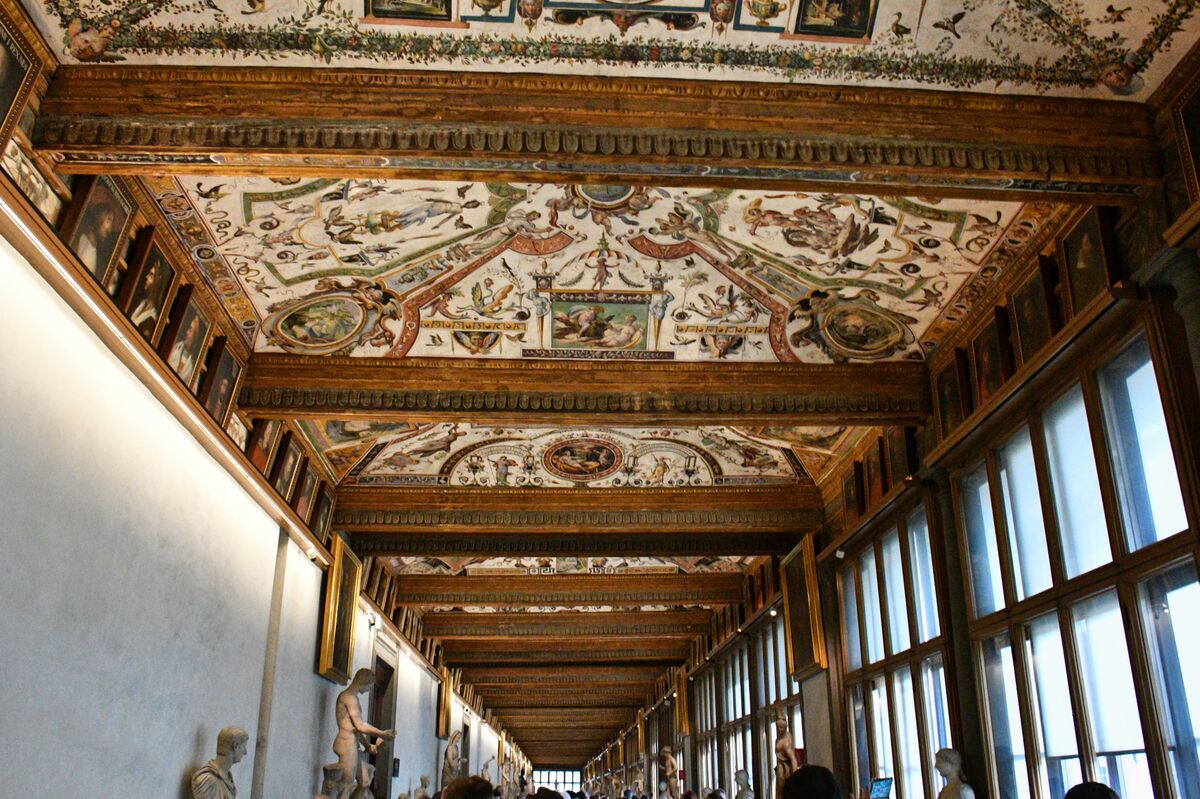
(Download)
One of the many ancient Roman statues in the corridor
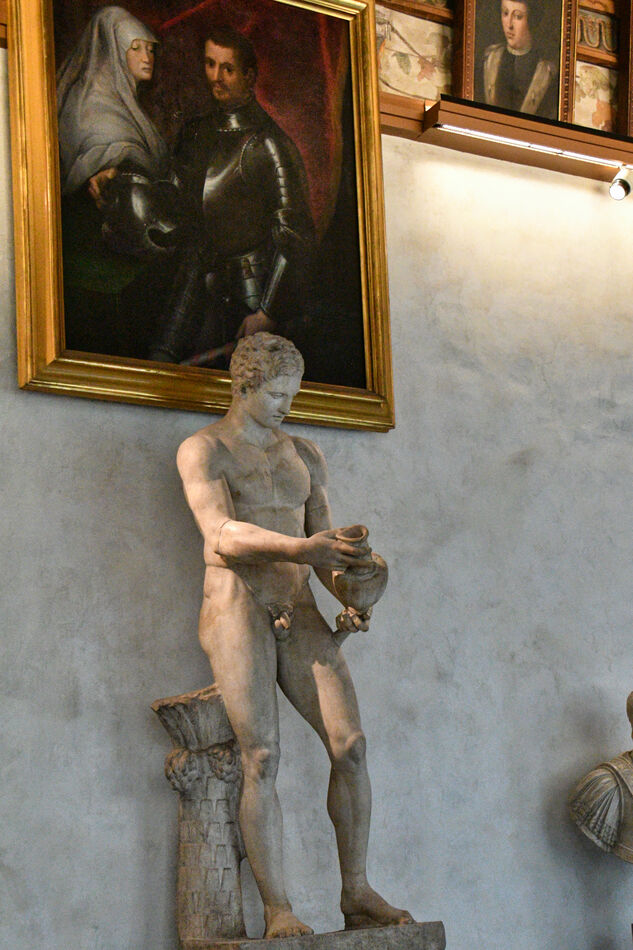
(Download)
Portrait of Cosimo I de'Medici
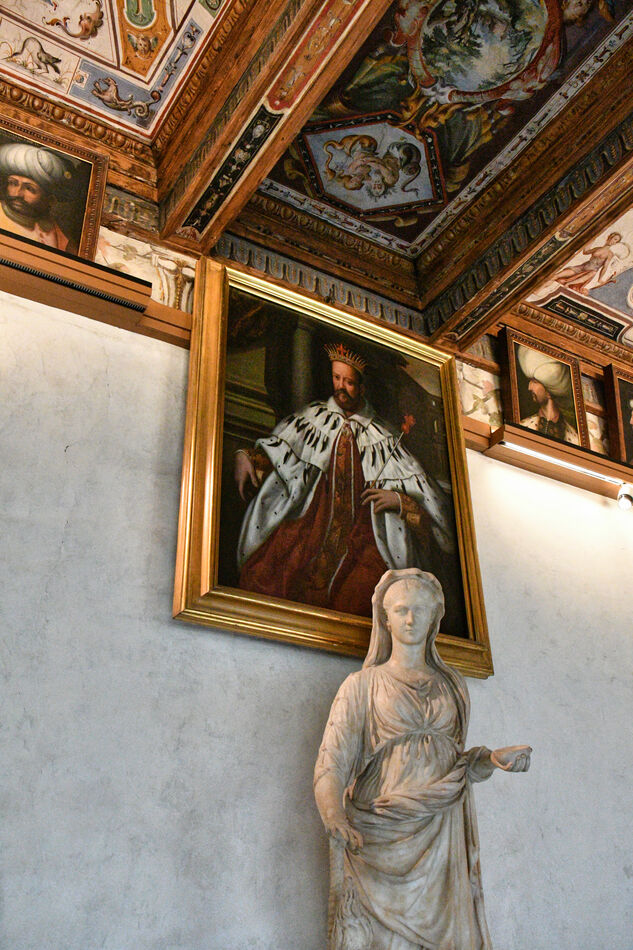
(Download)
The Ognissanti Madonna was executed in egg tempera and painted by Giotto in 1310 on a large panel that measures 325 by 204 centimetres
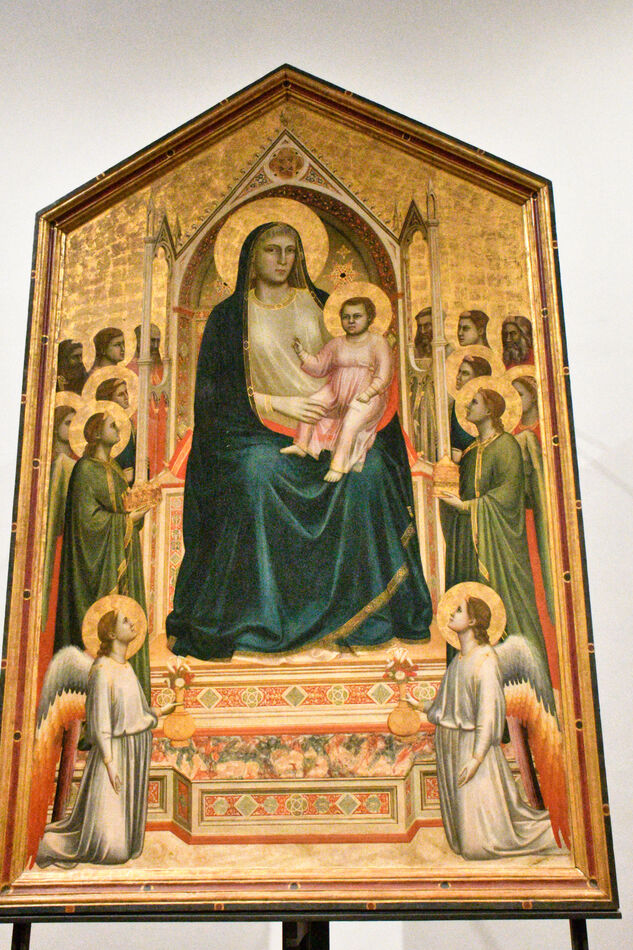
(Download)
Enthroned Madonna With Angels - Cimabue 1285
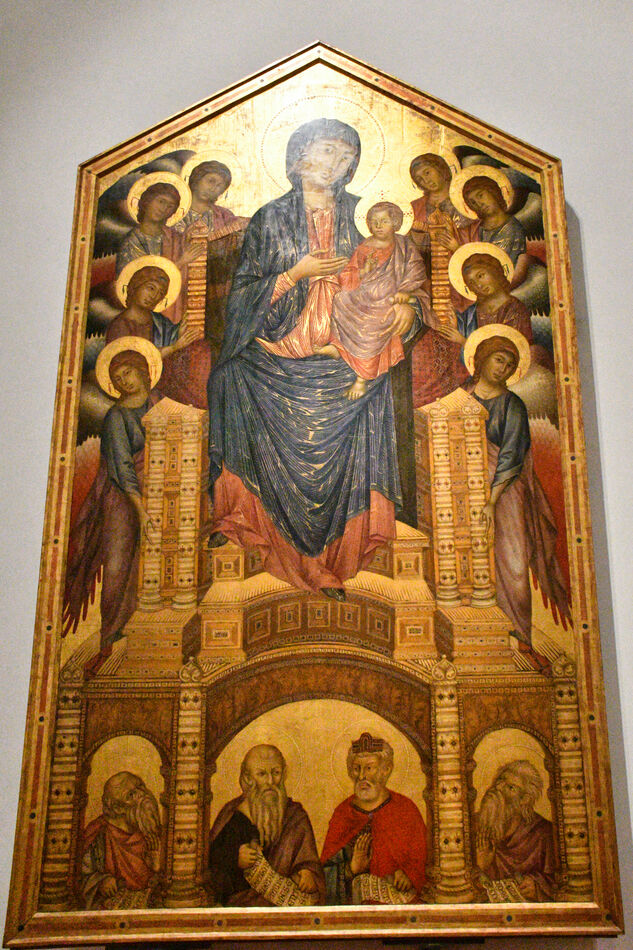
(Download)
Piero della Francesca's "Portrait of Battista Sforza and Federico da Montefeltro" Diptych done 1472-1475
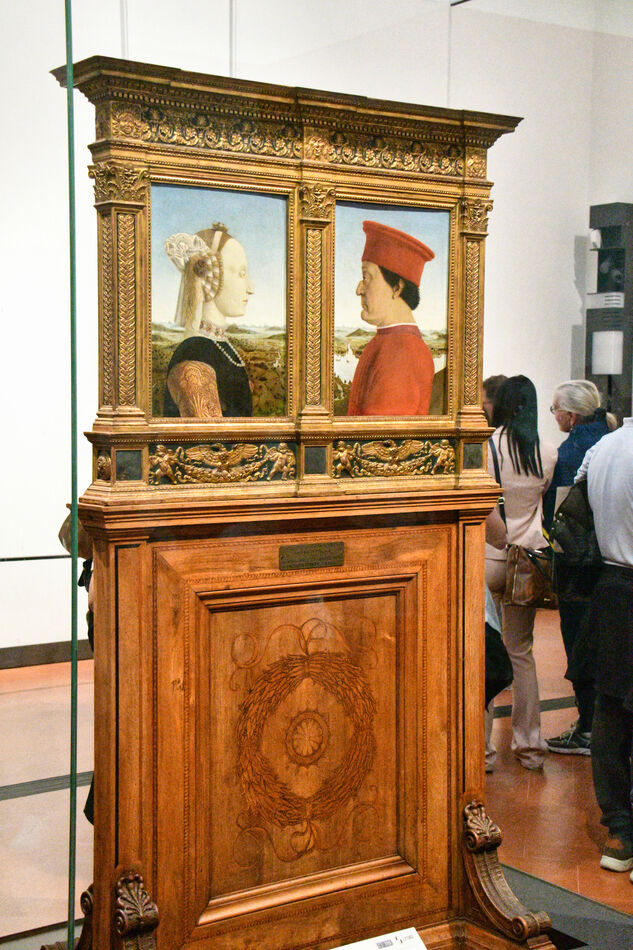
(Download)
Scenes of allegorical triumphs on the back of the double portrait of Battista Sforza and Federico Montefeltro. I love the faces of the crowd.
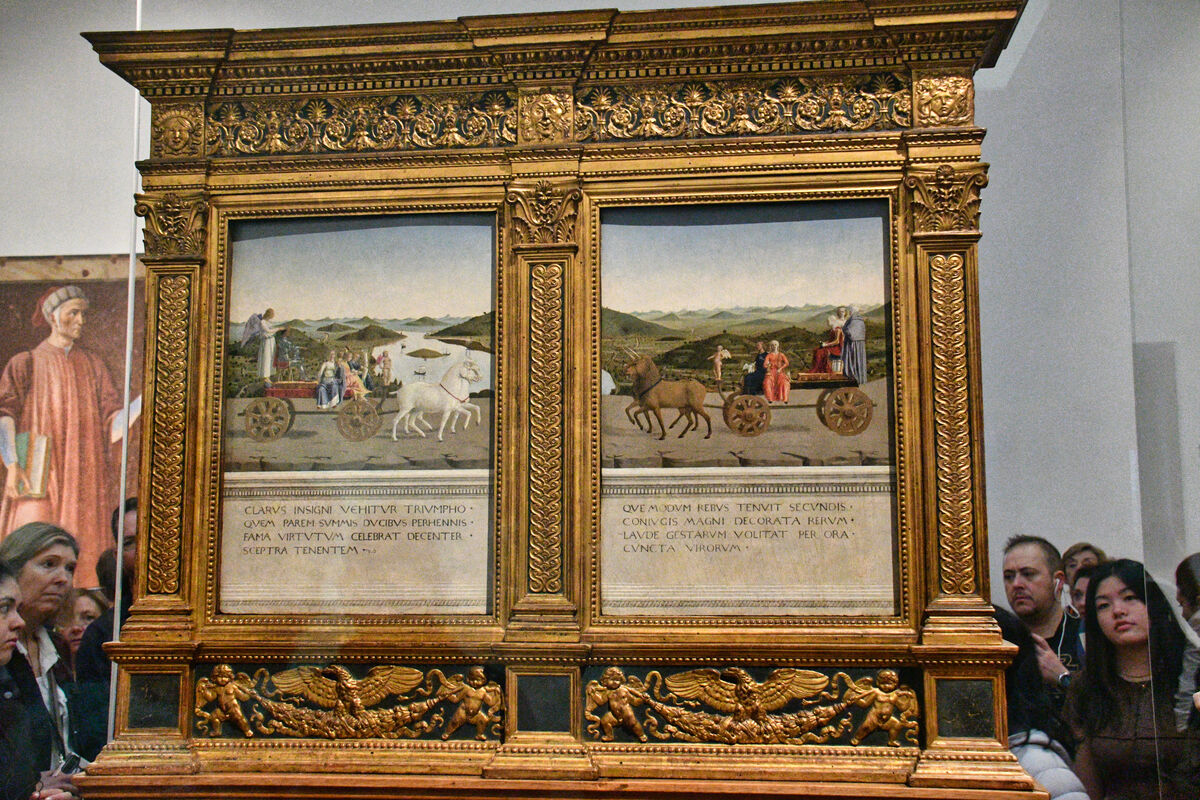
(Download)
Madonna and Child with two Angels Filippo Lippi1460 - 1465
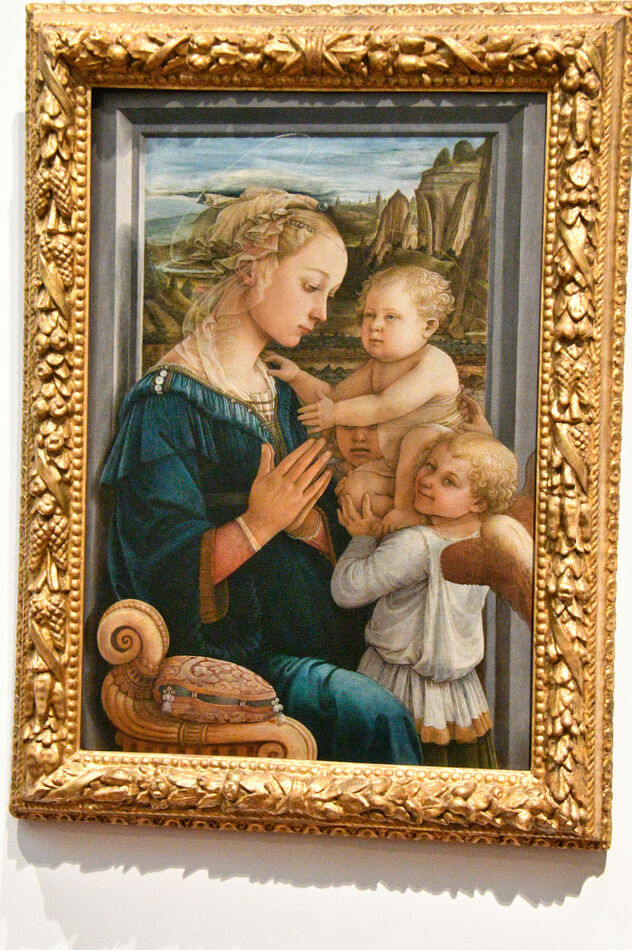
(Download)
The Battle of San Romano is a set of three paintings by the Florentine painter Paolo Uccello depicting events that took place at the Battle of San Romano between Florentine and Sienese forces in 1432.
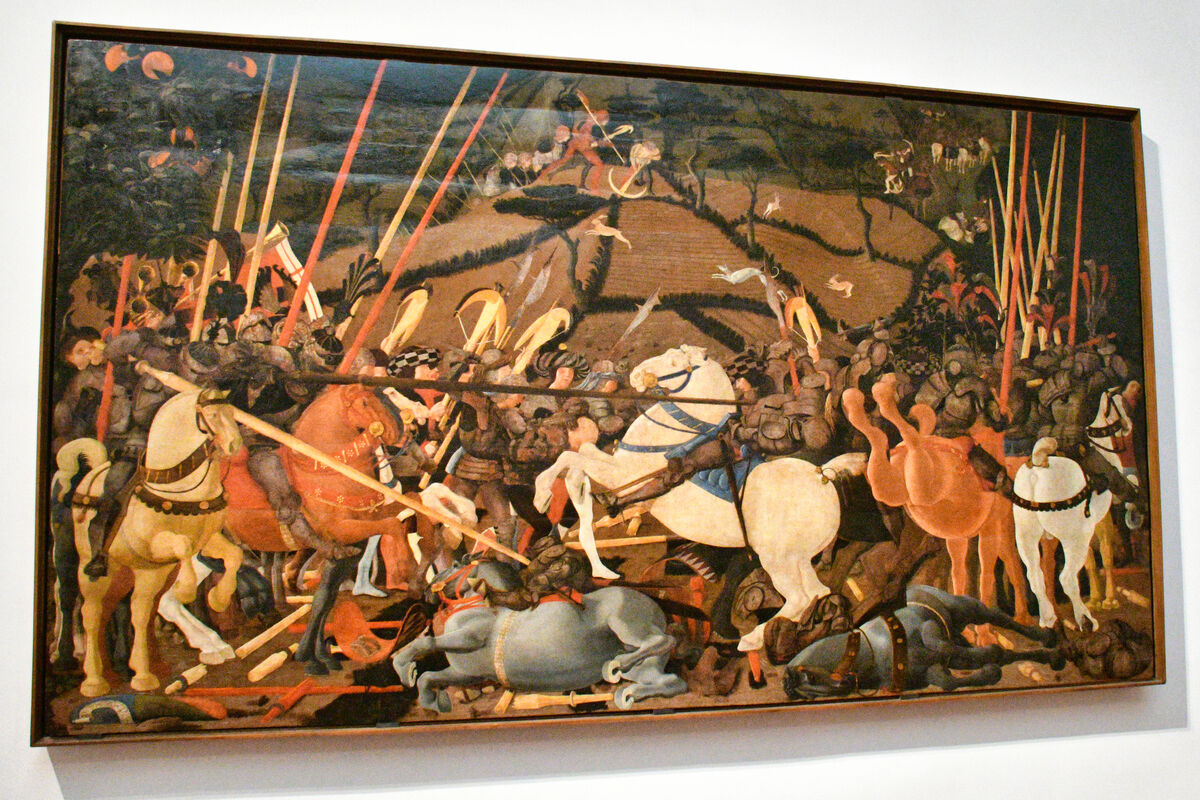
(Download)
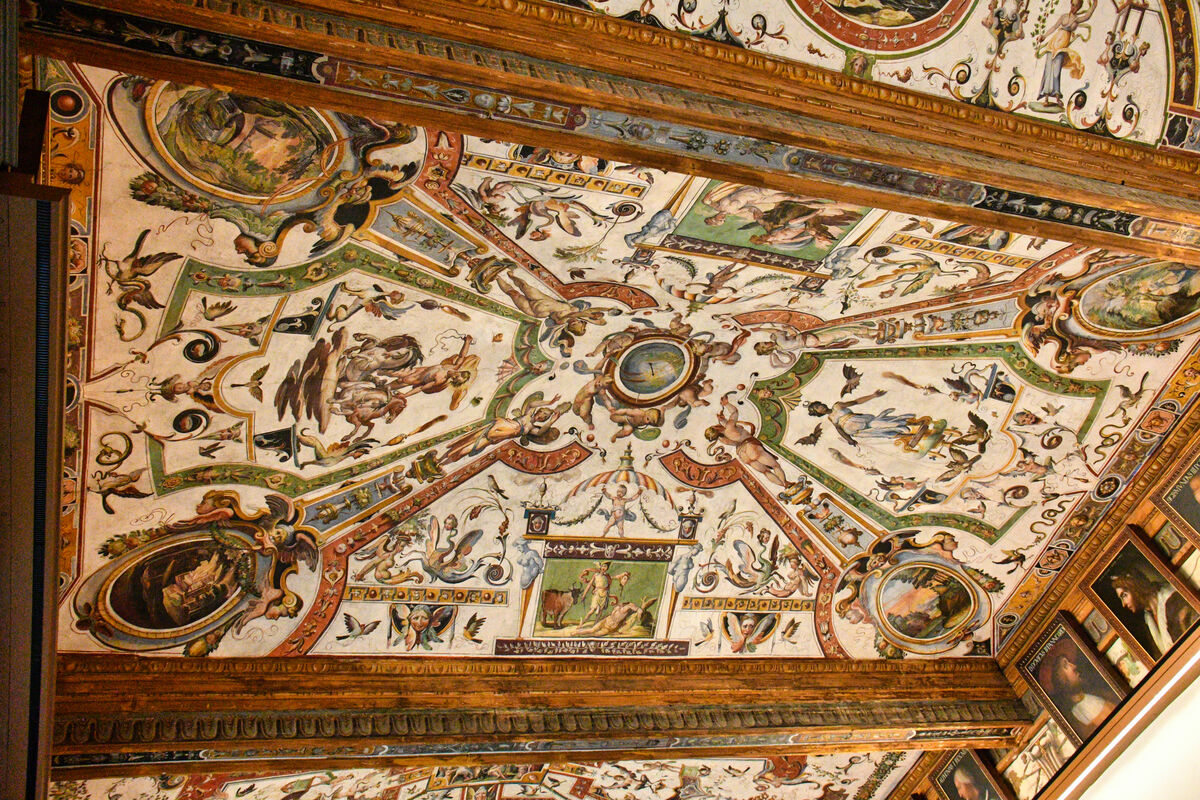
(Download)
Aug 23, 2023 14:53:05 #
Aug 23, 2023 15:42:40 #
Aug 23, 2023 16:38:30 #
srfmhg wrote:
We braved the crowds for a tour of the Uffizi Gall... (show quote)
The Uffizi is a must-see museum. Excellent narrative and many of the same photos from our visit there in June of last year. Well done Mark.
Aug 23, 2023 17:01:27 #
NMGal wrote:
I think their sculptures are better than their paintings.
I happen to like sculpture better as well but some of the paintings are awesome. Thanks Barbara.
Aug 23, 2023 17:02:10 #
DJphoto wrote:
The Uffizi is a must-see museum. Excellent narrative and many of the same photos from our visit there in June of last year. Well done Mark.
Thanks very much Dennis. The artwork is timeless!
Aug 23, 2023 17:17:10 #
Aug 23, 2023 17:29:54 #
UTMike wrote:
Good work in the mob, Mark!
Thanks very much Mike. It was tough and very intimidating for Gail since she's small.
Aug 23, 2023 18:12:32 #
srfmhg wrote:
We braved the crowds for a tour of the Uffizi Gall... (show quote)
About time to see you in the company of other Masters 🔔🏆👑🏆🔔
Aug 23, 2023 18:17:48 #
joecichjr wrote:
About time to see you in the company of other Masters 🔔🏆👑🏆🔔
Thank you so much for this undeserved compliment!!!
Aug 23, 2023 19:28:33 #
Very nice set of some beautiful art, Mark. I could never brave those crowds, though.
Aug 23, 2023 19:40:20 #
Enjoyed seeing these, many of which were displayed in my college art history books. I’m always impressed by how many have survived the test of time. Of course some credit goes to curators and those responsible for restoring and maintaining the paintings and sculptures.
We took a day trip up from Rome on the wrong day. The museum was closed. However, we were able to see the “outside” David in addition to the usual tourist attractions in the area. Thankfully, as you might expect, it was not crowded.
Your wonderful travel photos and accompanying narratives are always a pleasure. Keep them coming.


We took a day trip up from Rome on the wrong day. The museum was closed. However, we were able to see the “outside” David in addition to the usual tourist attractions in the area. Thankfully, as you might expect, it was not crowded.
Your wonderful travel photos and accompanying narratives are always a pleasure. Keep them coming.



Aug 23, 2023 20:23:54 #
kpmac wrote:
Very nice set of some beautiful art, Mark. I could never brave those crowds, though.
Thanks very much Ken. The crowds were oppressive but seeing the masterpieces in person was well worth it.
Aug 23, 2023 20:27:32 #
vicksart wrote:
Enjoyed seeing these, many of which were displayed... (show quote)
Thanks so much for your kind comments Vicki. Many weeks of posts to come. I'm trying to keep up with processing. Lots of time researching some of the more minor pieces since I don't remember the names and dates. I am enjoying the re-education though!
Aug 24, 2023 07:24:49 #
If you want to reply, then register here. Registration is free and your account is created instantly, so you can post right away.

